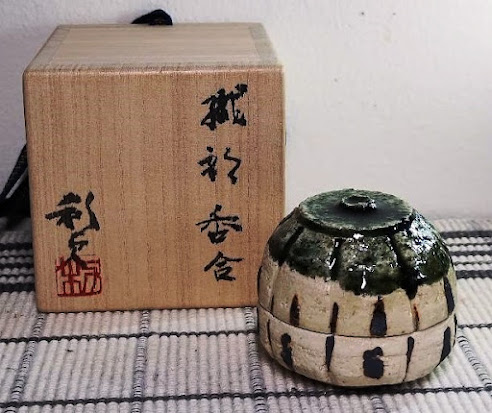248. WAKAO Toshisada 若尾利貞, 1933- , Oribe kōgō 織部香合 (Oribe-ware incense box)
Wakao was born in Tajimi. After graduating from junior high school, he worked at a ceramics factory while studying Shino-ware on his own. He went independent in 1970. He is a recipient of the Katō Kōbei Award, the Mino Newcomer’s Award, and the New Craft Award, among other honors. He has been a participant and award-winner at the Chūbu Art Exhibition, Gifu Prefectural General Design Exhibition, Asahi Ceramics Exhibition, Japanese Traditional Crafts Exhibition, and the Chūnichi International Ceramics Exhibition. He has had solo exhibitions held at the Nihonbashi Takashimaya, Nagoya Matsuzakaya, and Tokyo Tsubogen, among other venues. He is a member of the Japan Kōgei Association.
Cream-colored clay, with Oribe green, brown, and cream glazes; the edges where the two halves meet are unglazed. Weight: 102 g (3.6 oz). Height: overall, 4.3 cm (1-3/4 in). Width: 6 cm (2-3/8 in).
Bottom part: This sits on a foot ring 3.7 cm (1-1/2 in) in diameter and about 0.3 cm (1/8 in) high on both sides. Within the ring is the artist’s sigil written with a brush in brown glaze. Above the foot ring, the walls flare outward at about a 45-degree angle to meet the sides 0.5 cm (3/16 in) above the base. The walls rise in more or less a straight line to the top of the bottom part 1.8 cm (3/4 in) above the base; at this point the piece has a diameter of 3.2 cm (1-1/4 in). There is a horizontal shelf about 0.5 cm (3/16 in) wide on which the top part rests. At the inside edge of this shelf is a vertical flange 0.8 cm (5/16 in) high. The interior of this part mirrors the shape of the exterior walls.
Top part. Overall, this part is 3.2 cm (1-1/8 in) high. The bottom edge is flush with the top edge of the bottom part; The walls are 0.5 cm (3/16 in) thick. Above this, the walls curve inward in a high convex arc to a flat circular area at the top 3.4 cm (1-1/4 in) in diameter. In the center of this is a roughly circular small button less than a centimeter (3/8 in) in diameter. The interior of this part mirrors the shape of the exterior.
There are eight vertical grooves extending from the circle at the top of the upper part across the body of the piece to the lower edge of the walls. The texture of the exterior is bumpy; the interior is smooth.
The circle at the top and the upper half of the top part were covered with the green Oribe glaze. Below this each groove was filled in with the brown Oribe glaze; between each of these lines Wakao used the brown glaze to draw an irregular vertical shape. Wakao also used this glaze to draw his sigil on the base. Other than the edges where the halves meet, the rest of the piece has a cream glaze.
This
came in a small wooden box inscribed by the artist in two lines: 織部香合 / 利貞 Oribe kōgō
/ Toshisada (Oribe incense container / Toshisada), followed by the artist’s
seal stamped in red. Included in the box were a blue wrapping cloth, also
stamped with the artist’s seal in red, and a short biography.
Purchased
from Dai Ichi Arts in New York City in May 2024. (invoice, shipping label)












No comments:
Post a Comment